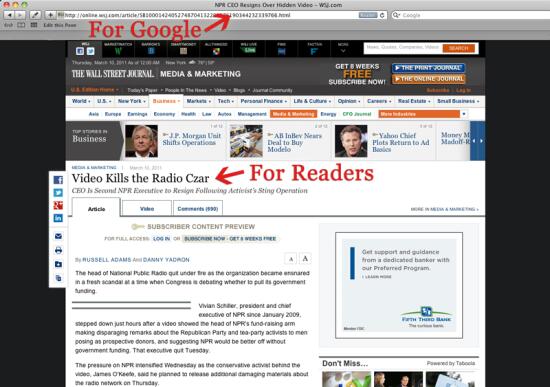Blogging for SEO Part 2: Keyword Targeting
In the first post in this series, we looked at how to conduct keyword research for blog posts. If you’re looking to get the most SEO value out of your content, discovering and analyzing keywords is an essential first step. After you’ve put in a little work to identify a primary keyword phrase, you can then proceed with keyword targeting.

You now have an interesting, well-written blog post in one hand, and a relevant keyword in the other. The next step is to target that keyword throughout the blog post, by adding and implementing it in a few crucial places throughout the content. Chances are, this keyword (or one very similiar) already appears in your post, so this step is about tweaking and refining to effectively tell searchers and search engines what that post is about. An optimized blog post will rank higher for that target keyword, leading to a greater number of impressions on search engine results pages.
Keep in mind, you never want to overstuff your post with one keyword - search engines might mistake your post for spam and not rank it at all. And, no one wants to read a post that was written for a search engine. So look to add your keyword in a few meaningful places throughout while still keeping your content readable and enjoyable for visitors.
6 Places to Target Keywords
1. Page Title
On-page SEO is about appealing to human readers and search engines, without neglecting either. When it comes to headlines and search engines, you’ve got to remember that Google doesn’t laugh. A funny or clever headline could go unrecognized by search engines and be a detriment to your blog posts’ rankings. This is why it’s a good idea to optimize your page title separately from your headline, even though many content-management systems automatically generate one from the other.
Check out how the Wall Street Journal optimizes their headlines and page titles for SEO. “Video Killed the Radio Czar” is a fun play on words for readers, but the much more literal page title “NPR CEO Resigns Over Hidden Video” appeals to search engines.

One of the most important keyword elements for search engines is your page title. It should be a short, relevant title for the post with your primary keyword somewhere in the mix. Position your target keyword as the first word or early on for maximum impact.
2. Headline
The blog post headline, or H1 text, is one of the most important aspects of on-page SEO for your readers. It’s your first impression. The headline and a link to the blog post are usually all people see when it’s shared on Twitter, Facebook and other social networks. So you’ve got to make it count.
Your headline can be witty, ask a question or be simple and to-the-point. Either way, it’s ideal for your keyword to appear somewhere in your headline. Remember, readers are unlikely to read a post unless they know what it’s about!
3. URL
Any good content-management system will give you the ability to customize your URL, and some will do it for you. The point is, this is another essential place to add your keyword. A good rule of thumb is to base your URL off of your page title (which should already have the keyword in the first few words.) Check out the URL of this post:
/blog/blogging-for-seo-keyword-targeting
Compared to, say:
/blog/post-34 or /blog/82093840
4. Image File Name and Description
Before uploading an image for the blog (which you should always try to include,) change the filename of the image to include the target keyword. Then, use the keyword in the title and description before uploading it to the page.
5. Meta Description
The meta description is the phrase your potential readers see under your page title in search results. Writing an optimized meta description won’t really help your rankings, but it does encourage click-through from search engines and social media posts. Rather than letting the meta description generate automatically, write a short, compelling sentence between 130-150 characters that includes your keyword.
6. Content
The keyword phrase you selected to target should be extremely relevant to the post at-hand, so it should be relatively easy to find a few places within the content to add it in. Remember that you can over-optimize by adding it too many times. So, use these general guidelines:
- Add keyword once in the first or second paragraph
- Add keyword once in the last paragraph
- If there are any lists with bolded headers or sub-headings on the page, try to incorporate the keyword phrase in at least one <b> or <h> tag. If not, don’t worry about it.
- A few other places in the content, only if it makes sense.
After completing these steps, you should now have a well-optimized blog post that’s (almost) ready to be posted! In our third part of the Blogging for SEO series, we’ll talk about the final step in the process, building links in to your content.
(Photo © Flickr User ogimogi / Licensed through the Creative Commons)
____
Further reading: An SEO Checklist for Writing Blog Posts, Make or Break your SEO: URLs & Title Tags


Comments
Asher Elran
For the body of the text in order not to have a very high keyword density and be able to target needed keywords at the same time, the best practice is to use synonyms, instead of repeating the same keyword phrase over and over. It is recommended not to have the keyword density over 3% in the body of your blog post.Jai Catalano
Can you target a keyword a second time in another blog post or would you just add an anchor text? I understand one shouldn't give duplicate content but for ex this is part 2 which means you have a part one. Would love to hear your insight?sulman
NICE POST THANX FOR SHARINGjrm
Thank you for this article however, I have one question that has been killing me though, let's say I have a site when it was started the focus wasn't all there how do I know now which keywords I should be focusing on and how to capitalize on them??prabhuks
hi really it helped me alot thnx a lotLeave a comment